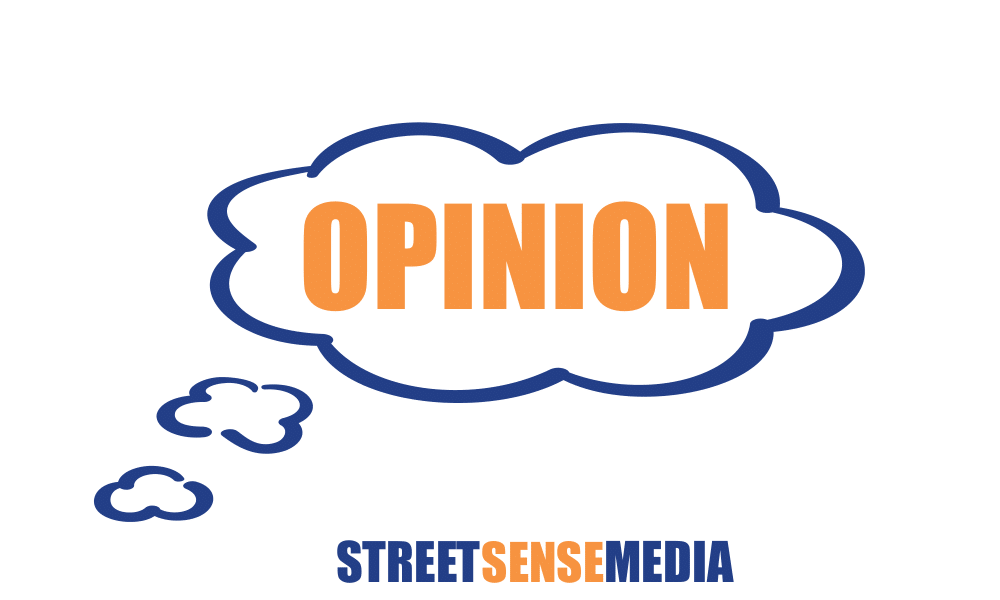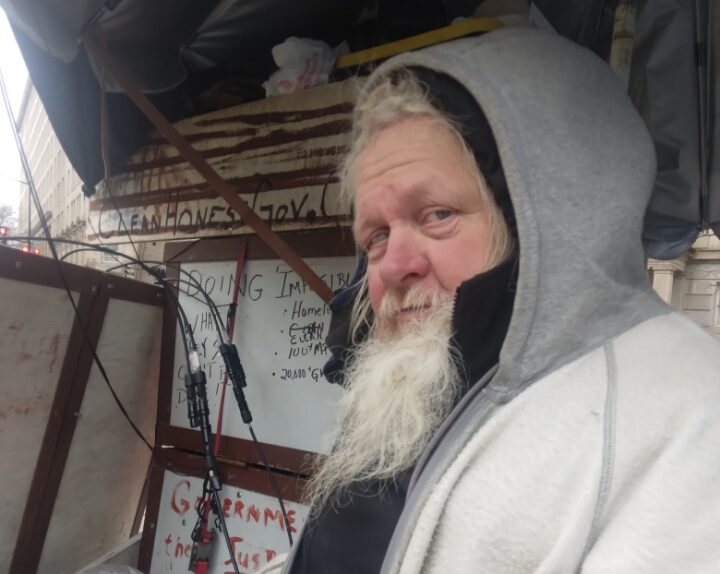I was on the National Mall when tens of thousands of Donald Trump supporters rallied on Jan. 6. They stood to watch a lineup of right-wing speakers, including Trump, urging them on shamelessly, claiming that Trump won the 2020 presidential election.
A woman speared me in the neck with a flag pole bearing the Stars and Stripes. I wasn’t physically injured, but shaken up. She then walked towards me and picked up the flag pole with a toothy grin on her face. I was sure that the incident was an accident, until she walked away and disappeared into the massive crowd without offering an apology.
Still the optimist, I searched the white faces of the group of onlookers, hoping to find one that was filled with outrage over the incident. To my disappointment, there were none.

I then wandered throughout the crowd taking portraits. I saw few Black people, other than myself. The rally felt like history repeating itself in front of my eyes, a reminder of when Black people were lynched with impunity throughout the country, particularly in the South, where it all began for me.
The Equal Justice Initiative documented 4,440 lynchings in the U.S. between 1877, the end of post-Civil War reconstruction, through 1950. Domestic terrorists such as the Ku Klux Klan used lynching as an instrument of fear to dominate and control Black people.
America’s history of lynching is largely ignored. This indifference contributed to the deaths of African Americans today at the hands of police.

The deaths of Michael Brown, Breonna Taylor, George Floyd, and thousands of others could have been prevented if the country had raced swiftly to put an end to racial bigotry.
Floyd gasped for air and called out to his dead mother while a white Minneapolis police officer pressed his knee into his neck for 8 minutes and 46 seconds. Before he died, Floyd pleaded repeatedly to the officers, “Please, I can’t breathe.” Former police officer Derek Chauvin faces murder charges in the death of Floyd last Memorial Day. In the much anticipated trial, the jury selection has begun. Three other former officers on the scene in Floyd’s death were charged with aiding and abetting murder. Their trial is set for August.
Those former officers are described by some as the bad apples in the barrow. The bad apple theory blames a few officers for police brutality, and defends the many as good cops. But what if policing in America is akin to the lynch mob?
There is a double standard in law enforcement. Take, for example, the halfhearted response of the Capitol Police to the mostly white Trump supporters who stormed the Capitol. It stood in stark contrast to the way in which law enforcement treated Black Lives Matter protesters last summer.

Not surprisingly, hundreds of Donald Trump supporters who stormed the U.S. Capitol building on Jan. 6 to prevent a vote certifying Joseph Biden’s Electoral College victory. They set up a gallows and hangman’s noose near the Capitol grounds, and hunted for lawmakers to attack throughout the halls of Congress. They chanted “Hang Mike Pence.” Lawmakers and their staffs, some with family members, huddled together in fear behind makeshift barricades made of office furniture. The trauma of waiting for help seemed endless, some recounted.
Violent extremism and white supremacy have been brewing in this country for centuries. When the mob attacked the very seat of power, lawmakers acted surprised. Any Black person in the country could have warned them that the Capitol riot was bound to happen.
A quote from Martin Luther King Jr.’s 1963 Letter From a Birmingham Jail where he discussed the interrelatedness of all mankind: “Injustice anywhere is a threat to justice everywhere. We are caught in an inescapable network of mutuality, tied in a single garment of destiny. Whatever affects one directly, affects all indirectly.”
Lawmakers apparently didn’t heed King’s insight. As long as the lynchings were directed at Black people, my countrymen pretended not to see that the lynching victims needed help.

Imagine that the country had rooted out racial violence and bigotry long ago. We would be the better for it today.
House Democrats introduced a single article of impeachment charging Trump with high crimes and misdemeanors for inciting the marauders who assaulted the Capitol.
Trump’s impeachment trial was important, if for no other reason than the historical record it will produce. It might also serve as a lost opportunity for the American people to engage in a national town hall-style dialogue that takes a deeper dive into what happened that day.
Trump exploits a white electorate’s fear of loss for his own political self-interest. His brand of racist, political messaging is meant to incite and strike fear and anger toward immigrants and Muslims as well as Black, Latino, and Asian Americans.

Trump’s labeling of the coronavirus pandemic as the “China virus” makes some people blame Chinese Americans for the spread of the virus. In the Atlanta area, a gunman shot and killed eight people at massage parlors, including six women of Asian descent.
The advocacy group Stop AAPI Hate documented nearly 3,800 anti-Asian hate incidents in the past year.
Trump’s appeals ring true to white voters who see increasing diversity —– and the loss of white privilege —– as a threat.

Trump isn’t the first to use this tactic. The Tea Party movement came before him. Both wouldn’t exist if it weren’t for the unexpected election of President Barack Obama. Obama’s rise to the White House stirred nothing but fear in the group’s membership — especially the non-college educated, working class white men. The Tea Party consistently opposed Obama’s policy agenda, including Obamacare, even though much of it would have helped poorer white Americans as well.
Trump’s “Make America Great Again” slogan conjures up an idealized past when minorities and women were kept in their place, and the White man reigned supreme.
The angry white man is experiencing unease about his place in the future of America. The changing face of this country is looking back at him with a facial expression that says change hasn’t come fast enough. The prospect of the loss of status increases his frustration. So he turns to extremist groups, spouts conspiracy theories, and blames minorities for his troubles.

But there are ways to lessen this feeling of disenfranchisement. Countering violent extremism and white supremacy requires solving the legitimate challenges facing this group of people. For example, opioid abuse is still a pandemic, particularly in rural America. Unemployment, poverty, isolation, low education attainment, and lack of access to healthcare in those rural areas all make people more likely to turn to illicit substances. Real wages haven’t increased in this country for decades, and the income gap between the rich and working class continues to widen.
The Capitol riot highlights the country’s economic inequality. A minimum wage hike, jobs, and infrastructure program won’t solve all the problems, but that’s a good start. The country can no longer afford to turn a blind eye to these problems.
America is being divided by political puppet masters who exploit division for their own ends. Biden and Congress must find ways to unite the country.
This photo essay captures portraits of Trump supporters on the National Mall during the March to Save America rally on Jan. 6.

The atmosphere felt eerily similar to an anti-civil rights protest of the 1960s. Trump supporters carried the American flag and Trump 2020 flags, and more sinister symbols of white supremacy and violence extremism. One man held the Confederate battle flag. Some wore apparel with the bold letter Q, the symbol for the QAnon conspiracy theory, which alleges that famous Democrats belong to a cabal of Satan-worshiping pedophiles. Members of the far-right group Proud Boys flashed “OK” hand gestures, a symbol of white power.
After the neck-spearing incident, I plowed through the herd of Trump supporters, looking for subjects to photograph. Of course, I felt leery that something else bad would happen to me. As a photographer, though, I’d learned to soldier on when I was having a bad day. My apprehension soon eased, because I was accomplishing what I set out to do. The subjects of my photographs also helped to lift my spirits, because they appeared happy to be photographed. I approached them in a friendly manner and was up front about who I was and what I was doing. A few of my subjects had disarming smiles. They made me feel unexpectedly at ease, with less suspicion that they might be racist.
Most photographers were capturing shots of Trump supporters on the Mall. I know that it is difficult to see past the white supremacy regalia, but my goal was to make portraits of the individual. I made close up shots because I wanted the viewer to see their humanity. These are candid portraits with enough background to add meaning. I didn’t ask them to pose. They are presented here as they wanted to be seen.
There is more to life than the perceptions that are fed to us by the puppet masters. And with that realization comes the opportunity for the shackles to fall off, and for our mind and body to be renewed.

Joseph Young is an award-winning journalist living in Washington, DC. His photography has appeared in the Washington Post Magazine, Washington Times, Washington Afro Newspaper and Washington Informer. He earned a bachelor degree in art from the University of the District of Columbia, with a focus on photography, as well as a bachelor degree in English. He is also the grant recipient from the D.C. Commission on the Arts and Humanities for his photography series about people experiencing homelessness in the nation’s capital. The most recent museum acquisition of his work was by the Smithsonian Anacostia Community Museum.







